Barbara DANE 1964
"Bessie Smith in Stereo" said jazz critic Leonard Feather in Playboy when Barbara Dane burst onto the scene in the late '50s. To Ebony, she seemed "startlingly blonde, especially when that powerful dusky alto voice begins to moan of trouble, two-timing men and freedom...with stubborn determination, enthusiasm and a basic love for the underdog (she is) making a name for herself...aided and abetted by some of the oldest names in jazz who helped give birth to the blues..." The seven-page Ebony article -their first feature story about a white woman (Nov., l959)- was filled with photos of Dane working with Memphis Slim, Willie Dixon, Muddy Waters, Clara Ward, Mama Yancey, Little Brother Montgomery and others.
But where had she come from? Barbara's young parents arrived in Detroit, Michigan from Arkansas in the mid '20s, raising their family amid the deepest depression -as well as some of the worst race riots- the country had ever seen. Born in 1927 Barbara, right out of high school, began to raise her strong voice regularly at demonstrations for racial equality and economic justice. While still in her teens, she began to sit in with bands around town and won the interest of local music promoters. She even got an offer to tour with Alvino Rey's band, but she turned it down in favor of singing at factory gates and in union halls.
Moving to San Francisco in 1949, Barbara began raising her own family and singing her folk and topical songs around town as well as on radio and early TV. The traditional jazz revival was then shaking the town, and by the mid '50s she became a familiar figure at clubs along the city's Embarcadero with her own versions of the classic women's blues and hot jazz tunes. Visiting old-time New Orleans jazz greats like George Lewis and Kid Ory and locals like Turk Murphy, Burt Bales, Bob Mielke and others were inviting her onto the bandstand regularly. Her first professional jazz job was with Turk Murphy at the old Tin Angel in l956.
By 1959, Louis Armstrong had told Time magazine readers: "Did you get that chick? She's a gasser!" and invited her to appear with him on national television. She toured the East Coast with Jack Teagarden, played Chicago with Art Hodes, Roosevelt Sykes, Little Brother Montgomery, Memphis Slim, Otis Spann, Willie Dixon and others, played New York with Wilbur De Paris and his band, and appeared on Johnny Carson's Tonight Show as a solo guest artist. Other national TV work included The Steve Allen Show, Bobby Troop's Stars of Jazz, Playboy Penthouse, PM East/West and Alfred Hitchcock Presents.
In l96l Barbara opened her own club, Sugar Hill: Home of the Blues, on San Francisco's Broadway, with the idea of creating a respectful venue for the music right on the tourist rialto where a wider audience could come in contact with it. There Dane performed regularly with her two most constant musical companions: Kenny "Good News" Whitson on piano and cornet, and Wellman Braud, former Ellington bassist. Among her guest artists were Jimmy Rushing, Mose Allison, Mama Yancey, Tampa Red, Lonnie Johnson, Big Mama Thornton, Lightnin' Hopkins, T-Bone Walker, Brownie McGhee and Sonny Terry, as well as the many jazz musicians who came regularly to sit in.
"Why the blues?" says Barbara. "Because they speak from the heart to the heart. The blues were born out of the worst conditions one people can force upon another, out of slavery and exploitation -and were given to the world in the spirit of turning madness into sanity, pain into joy, bondage into freedom, and enmity into unity. This is music for survivors, and this spirit is something to be learned from, shared and spread as far as it will go! No matter what the words say, no matter who I'm singing to, this is always what I'm singing about."
During all her years singing blues and jazz, Barbara continued to weave in appearances as a solo performer on the coffeehouse circuit with her folk-style guitar. She also stepped up her work in the movements for peace and justice as the struggle for civil rights spread and the war in Vietnam escalated. She sang at every big peace demonstration in Washington and many of those in small towns and byways all over America, taking her songs to the Freedom Schools of rural Mississippi and right up to the gates of military bases from Japan to Europe as well as all over the USA. In l966, Barbara Dane became the first U.S. musician to tour post-revolutionary Cuba. The impact on the Cuban public was indelible, and she soon returned to take part in an international festival where she met other like-minded singers from all over the world. Through some of these singers, she was invited to tour in both Western and Eastern Europe, Mexico, Nicaragua, and the Far East, even to North Vietnam and the liberated areas of the South as the war still raged. To all these audiences she brought a range of American genres in order to communicate some of the complexities of American life, and with each encounter she incorporated new songs sung in their original languages or employing English lyrics she had begun to create. This latter work brought her into association with the great Greek composer Mikis Theodorakis, with whom she performed sections of his "Romiossini" with her English lyrics based on the poetry of Iannis Ritsos in Florence, Italy and in New York.
In 1970 Dane founded Paredon Records, with a deep commitment to making the music of the musicians and singers identified with the liberation movements then rocking the globe, many of whom she met during her travels, available to the U.S. listener. She produced 45 albums, including three of her own, over a 12 year period. The label was recently incorporated into Smithsonian-Folkways, a label of the Smithsonian Institution, and is available through their catalog.
Barbara's own recorded output has not been very readily available in recent years, but in 1996 Arhoolie Records issued a cd from some tapes recorded 30 years earlier singing solo and improvising blues with Lightnin' Hopkins. As a result of the critical buzz this created, Tradition Records reissued her only purely "folk" lp "When I Was a Young Girl" with Tom Paley on guitar and banjo in 1997 under the title "Anthology of American Folk Music". Barbara has also begun issuing some of her earlier blues and jazz recordings as cassettes on Dreadnaught Music in order to make them available to her new audiences.
After rambling through the music of the world, Barbara has returned at last to the blues. In December of 1997 she gave a solo concert at the Casa de las Americas in Havana, Cuba as the wrap-up of a year-long celebration of the 30th Anniversary of the Encuentro de Cancion Protesta, a series which included Angel and Isabel Parra of Chile and other international guest artists. For the first time in her performances there over the years, she featured a number of the blues which have been her main vehicle of expression, accompanied by two of Cuba's favorite guitar players: her son Pablo Menendez and her grandson Osamu. (She also had as special guests 80 year old Cuban piano maestro Ruben Gonzalez, renowned bassist Cachaito and Irakere drummer Enrique Pla)
Not long ago Philip Elwood, jazz critic of the San Francisco Examiner, said of her: "Dane is back and beautiful...she has an immense voice, remarkably well-tuned...capable of exquisite presentations regardless of the material. As a gut-level blues singer she is without compare."
But where had she come from? Barbara's young parents arrived in Detroit, Michigan from Arkansas in the mid '20s, raising their family amid the deepest depression -as well as some of the worst race riots- the country had ever seen. Born in 1927 Barbara, right out of high school, began to raise her strong voice regularly at demonstrations for racial equality and economic justice. While still in her teens, she began to sit in with bands around town and won the interest of local music promoters. She even got an offer to tour with Alvino Rey's band, but she turned it down in favor of singing at factory gates and in union halls.
Moving to San Francisco in 1949, Barbara began raising her own family and singing her folk and topical songs around town as well as on radio and early TV. The traditional jazz revival was then shaking the town, and by the mid '50s she became a familiar figure at clubs along the city's Embarcadero with her own versions of the classic women's blues and hot jazz tunes. Visiting old-time New Orleans jazz greats like George Lewis and Kid Ory and locals like Turk Murphy, Burt Bales, Bob Mielke and others were inviting her onto the bandstand regularly. Her first professional jazz job was with Turk Murphy at the old Tin Angel in l956.
By 1959, Louis Armstrong had told Time magazine readers: "Did you get that chick? She's a gasser!" and invited her to appear with him on national television. She toured the East Coast with Jack Teagarden, played Chicago with Art Hodes, Roosevelt Sykes, Little Brother Montgomery, Memphis Slim, Otis Spann, Willie Dixon and others, played New York with Wilbur De Paris and his band, and appeared on Johnny Carson's Tonight Show as a solo guest artist. Other national TV work included The Steve Allen Show, Bobby Troop's Stars of Jazz, Playboy Penthouse, PM East/West and Alfred Hitchcock Presents.
In l96l Barbara opened her own club, Sugar Hill: Home of the Blues, on San Francisco's Broadway, with the idea of creating a respectful venue for the music right on the tourist rialto where a wider audience could come in contact with it. There Dane performed regularly with her two most constant musical companions: Kenny "Good News" Whitson on piano and cornet, and Wellman Braud, former Ellington bassist. Among her guest artists were Jimmy Rushing, Mose Allison, Mama Yancey, Tampa Red, Lonnie Johnson, Big Mama Thornton, Lightnin' Hopkins, T-Bone Walker, Brownie McGhee and Sonny Terry, as well as the many jazz musicians who came regularly to sit in.
"Why the blues?" says Barbara. "Because they speak from the heart to the heart. The blues were born out of the worst conditions one people can force upon another, out of slavery and exploitation -and were given to the world in the spirit of turning madness into sanity, pain into joy, bondage into freedom, and enmity into unity. This is music for survivors, and this spirit is something to be learned from, shared and spread as far as it will go! No matter what the words say, no matter who I'm singing to, this is always what I'm singing about."
During all her years singing blues and jazz, Barbara continued to weave in appearances as a solo performer on the coffeehouse circuit with her folk-style guitar. She also stepped up her work in the movements for peace and justice as the struggle for civil rights spread and the war in Vietnam escalated. She sang at every big peace demonstration in Washington and many of those in small towns and byways all over America, taking her songs to the Freedom Schools of rural Mississippi and right up to the gates of military bases from Japan to Europe as well as all over the USA. In l966, Barbara Dane became the first U.S. musician to tour post-revolutionary Cuba. The impact on the Cuban public was indelible, and she soon returned to take part in an international festival where she met other like-minded singers from all over the world. Through some of these singers, she was invited to tour in both Western and Eastern Europe, Mexico, Nicaragua, and the Far East, even to North Vietnam and the liberated areas of the South as the war still raged. To all these audiences she brought a range of American genres in order to communicate some of the complexities of American life, and with each encounter she incorporated new songs sung in their original languages or employing English lyrics she had begun to create. This latter work brought her into association with the great Greek composer Mikis Theodorakis, with whom she performed sections of his "Romiossini" with her English lyrics based on the poetry of Iannis Ritsos in Florence, Italy and in New York.
In 1970 Dane founded Paredon Records, with a deep commitment to making the music of the musicians and singers identified with the liberation movements then rocking the globe, many of whom she met during her travels, available to the U.S. listener. She produced 45 albums, including three of her own, over a 12 year period. The label was recently incorporated into Smithsonian-Folkways, a label of the Smithsonian Institution, and is available through their catalog.
Barbara's own recorded output has not been very readily available in recent years, but in 1996 Arhoolie Records issued a cd from some tapes recorded 30 years earlier singing solo and improvising blues with Lightnin' Hopkins. As a result of the critical buzz this created, Tradition Records reissued her only purely "folk" lp "When I Was a Young Girl" with Tom Paley on guitar and banjo in 1997 under the title "Anthology of American Folk Music". Barbara has also begun issuing some of her earlier blues and jazz recordings as cassettes on Dreadnaught Music in order to make them available to her new audiences.
After rambling through the music of the world, Barbara has returned at last to the blues. In December of 1997 she gave a solo concert at the Casa de las Americas in Havana, Cuba as the wrap-up of a year-long celebration of the 30th Anniversary of the Encuentro de Cancion Protesta, a series which included Angel and Isabel Parra of Chile and other international guest artists. For the first time in her performances there over the years, she featured a number of the blues which have been her main vehicle of expression, accompanied by two of Cuba's favorite guitar players: her son Pablo Menendez and her grandson Osamu. (She also had as special guests 80 year old Cuban piano maestro Ruben Gonzalez, renowned bassist Cachaito and Irakere drummer Enrique Pla)
Not long ago Philip Elwood, jazz critic of the San Francisco Examiner, said of her: "Dane is back and beautiful...she has an immense voice, remarkably well-tuned...capable of exquisite presentations regardless of the material. As a gut-level blues singer she is without compare."
BARBARA DANE & LIGHTNIN' HOPKINS 1964

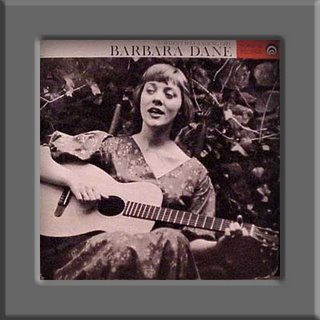
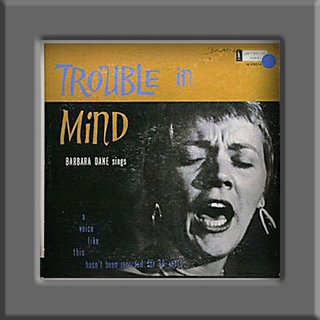
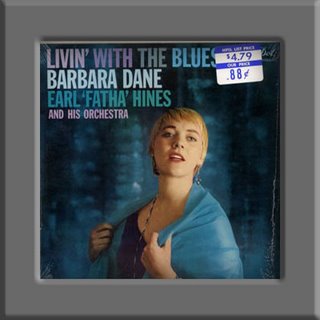
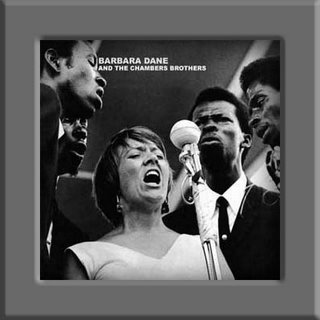
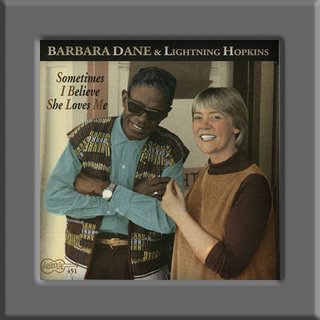


No comments:
Post a Comment